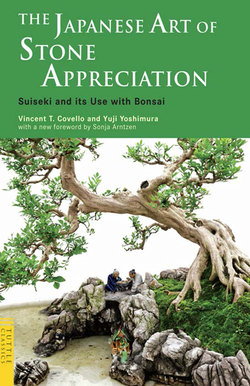Читать книгу Japanese Art of Stone Appreciation - Vincent T. Covello - Страница 8
На сайте Литреса книга снята с продажи.
ОглавлениеIntroduction
Suiseki are small, naturally formed stones admired for their beauty and for their power to suggest a scene from nature or an object closely associated with nature. Among the most popular types of suiseki (pronounced suu-ee-seck-ee) are those that suggest a distant mountain, a waterfall, an island, a thatched hut, or an animal (Figs. 28-30).
The art of suiseki is believed to have originated some two thousand years ago in China, where small stones of great natural beauty were set on stands to represent legendary islands and mountains associated with Buddhist or Taoist beliefs. In the sixth century A.D., emissaries from the Asian mainland brought several such stones to Japan. The Japanese adapted the art to their own tastes and have practiced it to this day.
Suiseki are traditionally exhibited on a carved wooden base or in a shallow tray. When formally displayed, suiseki are often accompanied by bonsai, dwarfed trees trained to grow into pleasing shapes. The term suiseki means literally “water stone” 水 sui, water; 石 seki, stone or stones). It is derived from the ancient custom of displaying miniature landscape stones in trays filled with water, and from the association between suiseki and classical Oriental landscape paintings of mountains and lakes. Prior to the Meiji era (1868-1912) a variety of other terms were used interchangeably to describe miniature landscape stones, including bonseki, bonzan, chinseki, kaiseki, and daiseki. By the latter part of the nineteenth century, however, the use of the word suiseki was firmly established among Japanese collectors, and it assumed precedence over all other terms.
In the last thirty years the popularity of suiseki in Japan has greatly increased. Numerous books in Japanese have been written on the subject, and annual exhibitions of suiseki are held in nearly every large Japanese city. Collectors roam the countryside looking for high-quality specimens, and some of their finds are sold for thousands of dollars.
Within the last decade an increasing number of non-Japanese, particularly Western bonsai and tray-landscape enthusiasts, have discovered the special beauty of suiseki. These new collectors share with their Japanese counterparts the challenge of searching for suiseki among thousands of ordinary stones, and the exhilaration of discovering a specimen that will be admired for generations to come.
